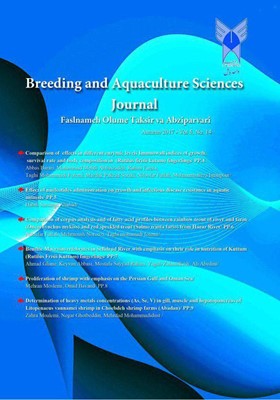Comparison of effects in different enzymic levels Immnowall indices of growth, survival rate and body composition in (Rutilus firisii kutum) fingerlings
Subject Areas : Breeding and Aquaculture Sciences JournalAbbas Barari 1 * , Mohammad Mehdi Abbaszadeh 2 , Rahim Farnia 3 , Taghi Mohamamdi Fotemi 4 , Mazdak Pakzad Soraki 5 , Niloofar Fallah 6 , Mohammad Reza Imanpour 7
1 - Ph.D. Candidate in Agricultural Sciences and Natural Resources of Gorgan, Iran
2 - Ph.D. Candidate in Fishery, Babol Branch, Islamic Azad University, Babol, Iran
3 - Department of Fisheries of Mazandaran Province, Babolsar, Iran
4 - Ph.D. Candidate in Fishery, Babol Branch, Islamic Azad University, Babol, Iran
5 - Department of Fisheries of Mazandaran Province, Babolsar, Iran
6 - Ph.D. Candidate in Fishery, Babol Branch, Islamic Azad University, Babol, Iran
7 - Professor of Agricultural Sciences and Natural Resources University, Gorgan, Iran
Keywords: Growth indices, Survival, body composition, Kutum (Rutilus frissi kutum), Immnowall,
Abstract :
This study was undertaken to evaluate the effects of Immnowall on feed intake, weight gain, food conversation ratio, specific growth rate, total length and survival of juvenile Kutum, Rutilus frisii kutum. For this purpose, 300 fish were stocked in three replications at the VENIRO tanks and fed twice daily by 0.5, 1 and 1.5 g/Kg of Immnowall for 8 weeks. Results showed that growth factors including: weight gain, specific growth rate, growth rate, feed conversion ratio and body weight index for fish administrated by 0.15 percent Immnowall showed a statistical significant differences (P<0.05) by control. Protein rate increased in probiotic treatment ( 4,5 and 6 with 0.05, 0.1 and 0.15 percent Immnowall in diet )of carcass analysis and showed a statistical significant differences (P<0.05) by control. Moreover, fish fed by 0.05 percent Immnowall and 0.15 percent Immnowall multienzyme showed a significant difference (P<0.05) in higher survival rate than control.
Afshar, N. (2002). Scientific guide of nutrition, food input and Aquaticmedicine in Iran. Tehran: Samarang Publication, p 216.
2. AOAC. (2000). Official Methods of Analysis. Association of Official Analytical Chemists, Arlington, VA
3. Fuller, R., (1989). Probiotics in man and animals. Journal Applied Bacteriology, 66, 365-378.
4. Gibson, G.R., Roberfroid, B., (1999). Dietary modulation of the human colonic microbiota: introducing the concept of prebiotics. Journal of Nutrition. 125,1401–1412.
5. Hung, S.S.O; lutes, P.B. and Storebakken , T, (1989). Growth and feed efficiency of whitesturgeon (Acipenser transmontanus) sub yearling at different feeding rates . Aquaculture .vol. 80, 147-153.
6. Irianto, A., Robertson, P.A.W., Austin, B., (2002). The use of probiotics in aquaculture :Recent Research and developments in microbiology. 4, 557-567.
7. Mahious A.S and Frans Ollvier. (2005). Effect of dietery inulin and oligosaccharides as prebiotics for weaning turbot, psetta maxima. Aquaculture international. 25, 37-46.
8. Mohantry, B.R., Kadirvel., S.K., Natarajan, R., Bhaskaran, M., (1996). Effect of probiotic supplementation on growth nitrogen utilization and serum cholestrol in broilrs. Brithish Poulty Science, 37: 395-401
9. Panahi, P. (2001). Biochemistry Basics. Tehran University Publication. P 153, 162-163.
10. Peng, A and Gatlin,S. (2003). The role of probiotics in aquaculture. Veterinary Microbiology, 114, 173–186.
11. Shiekhol Islami, M. (2008). The effect of level 1%, 2% and 3% in Pribiotic Inolin on th growth, survivability and bacterial flora of digestive system of rainbow trout. Msc. Thesis. Marine Science and Technology University of Khoramshahr. P 90.
12. Verschuere, L., Rombout, G., Sorgeloos, P., Verstraete, W., (2000). Probiotic Bacteria as Biological Control Agents in Aquaculture. Microbiology And Molecular Biology Reviews. 64, 655-671.
_||_
Afshar, N. (2002). Scientific guide of nutrition, food input and Aquaticmedicine in Iran. Tehran: Samarang Publication, p 216.
2. AOAC. (2000). Official Methods of Analysis. Association of Official Analytical Chemists, Arlington, VA
3. Fuller, R., (1989). Probiotics in man and animals. Journal Applied Bacteriology, 66, 365-378.
4. Gibson, G.R., Roberfroid, B., (1999). Dietary modulation of the human colonic microbiota: introducing the concept of prebiotics. Journal of Nutrition. 125,1401–1412.
5. Hung, S.S.O; lutes, P.B. and Storebakken , T, (1989). Growth and feed efficiency of whitesturgeon (Acipenser transmontanus) sub yearling at different feeding rates . Aquaculture .vol. 80, 147-153.
6. Irianto, A., Robertson, P.A.W., Austin, B., (2002). The use of probiotics in aquaculture :Recent Research and developments in microbiology. 4, 557-567.
7. Mahious A.S and Frans Ollvier. (2005). Effect of dietery inulin and oligosaccharides as prebiotics for weaning turbot, psetta maxima. Aquaculture international. 25, 37-46.
8. Mohantry, B.R., Kadirvel., S.K., Natarajan, R., Bhaskaran, M., (1996). Effect of probiotic supplementation on growth nitrogen utilization and serum cholestrol in broilrs. Brithish Poulty Science, 37: 395-401
9. Panahi, P. (2001). Biochemistry Basics. Tehran University Publication. P 153, 162-163.
10. Peng, A and Gatlin,S. (2003). The role of probiotics in aquaculture. Veterinary Microbiology, 114, 173–186.
11. Shiekhol Islami, M. (2008). The effect of level 1%, 2% and 3% in Pribiotic Inolin on th growth, survivability and bacterial flora of digestive system of rainbow trout. Msc. Thesis. Marine Science and Technology University of Khoramshahr. P 90.
12. Verschuere, L., Rombout, G., Sorgeloos, P., Verstraete, W., (2000). Probiotic Bacteria as Biological Control Agents in Aquaculture. Microbiology And Molecular Biology Reviews. 64, 655-671.

